Whiplash Snuffs the Candle Flame
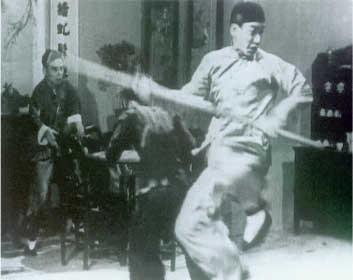
Reviewed by Yves Gendron

There is a beginning for everything and one could say that the "kung-fu movie" (even though the term itself would not be coined until the early seventies) started with THE TRUE STORY OF WONG FEI HUNG: WHIPLASH SNUFFS THE CANDLE FLAME way back in 1949.
Of course, there were wuxia films (the generic Chinese term for martial arts fiction) that came before, but they were quite fantasy-oriented in both plot and the depiction of martial arts. TRUE STORY was the very first martial-arts movie that aimed for a realistic display of authentic martial arts in a realistic setting. Furthermore, this was the first film about Wong Fei-hung, a famed turn-of-the-century folk hero of Southern China who had become a star of pulp fiction literature and radio shows since his death a quarter of a century before. It was also the film in which Chinese opera actor Kwan Tak-hing created the part of Wong which he would continue to play for nearly 80 films over four successive decades. Not only did he become the very first great kung-fu film star, but also the most beloved; the venerable patriarch of the whole genre.
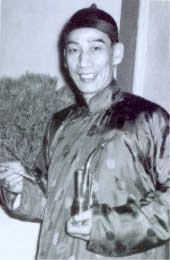
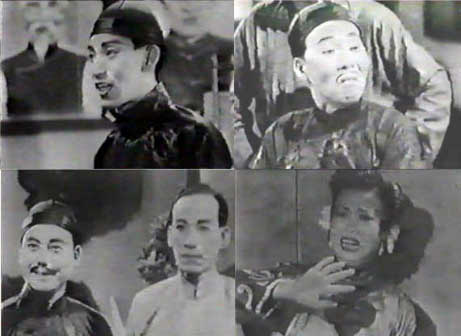
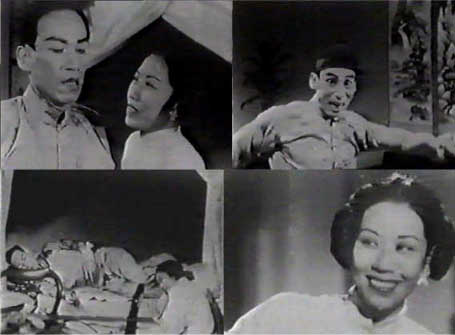
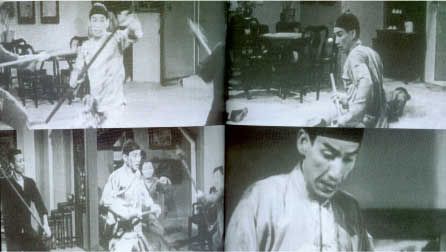
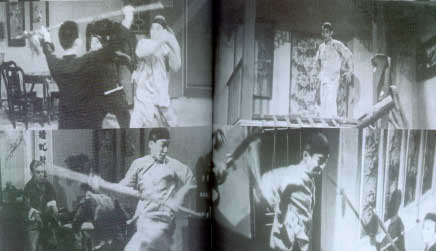
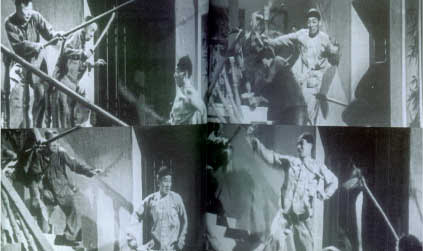
Ironically enough, it seemed that for a while, the lead role itself would be played by a non-martial performer, as Wu Peng had his eyes on an established Cantonese star named Wu Chu-fan. Another non-fighting popular actor, Cho Tat-wah was to play the master's lead disciple Leung Foon, and a Miss Hong Kong pageant winner was picked up to be the female lead, but in the end, the W-F-H part itself finally fell to opera performer/actor Kwan Tak-hing. He turned out to be, of course, the ideal choice, as he was a genuine martial-artist, trained in many of the martial techniques practised by the real-life Wong such as Hung-kuen, pole-fighting and lion dance. His daring activities during WWII with his opera troupe and entertaining the soldiers behind enemy lines had already given him a heroic aura, as well as the nickname of "Patriotic Entertainer". Finally when the real widow of Wong, Mo Kwei-lan (who had come to live in H-K after her husband’s passing) proclaimed that Kwan had the exact likeness of her late husband. This was of course the greatest endorsement of all.
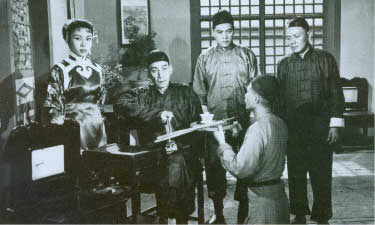
(Wong Fei Hung - Iron Cock Against
Centipede - 1956)
Something that might at first puzzle, and then perhaps annoy a western viewer, is that in many instances, the plot comes to a complete halt to accommodate extended vignettes showing martial-arts forms and various traditional folk customs. TRUE STORY actually opens with a lengthy lion dance display, flatly filmed like a documentary. Later, another blandly shot vignette shows a W-F-H disciple going through an elaborate pole form, and towards the end there is still another very lengthy interlude showcasing a singing street performer. The martial vignettes were actually there to push for the "authentic" take of the film by showcasing some fine and intricate martial displays. In a way, such scenes were the ancestors of the riveting training scenes of a later age.
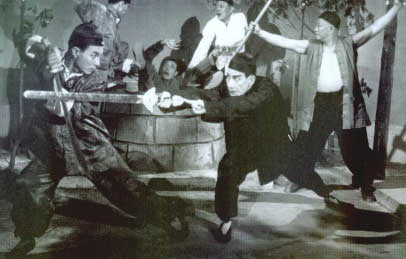
(Wong Fei Hung's Battle with the
Lion King -1957)
The folk custom sections filled a whole other purpose altogether, one linked with the movie's ulterior agenda. Imbued with both progressive ideas and an altruistic streak, Wu Peng envisioned TRUE STORY as a bit more than mere entertainment, as he wanted to use the cinematic medium to try to address and to soothe the grievous ills of his time. In 1949 China was in the last tremors of a costly civil war, with the Communist forces on the verge of complete victory. As result of this, the British colony of Hong-Kong, the country’s last safe haven, was now a huge, over-crowded urban refugee camp where the whole social order was under stress, and the traditional Southern China/ Cantonese cultural fabric was in tatters. Through the exemplary heroic figure of Wong Fei Hung, Wu sought to give the H-K people a much-welcomed uplifting boost. But even more, by also embracing the fully ethical aspects of martial-arts, not just it's fighting moves, he wanted the virtuous and dignified hero-patriarch to act as role model and moral guide. Thus we have Master Wong the martial fighter defending the downtrodden, as well as Master Wong, paragon of Chinese traditional values, using his fighting skills only as last resort, duly chastising a disciple who debased martial-arts by using it to settle some score, and making speeches on the paramount importance of ethics and virtues. Wu Peng's “educational” use of cinema did not end there, and that's where the filmed folk customs vignettes came into play. Through them Wu hoped to both preserve and diffuse Southern China’s endangered culture, and reinforce the sense of regional identity of the Cantonese- speaking viewers living both in H-K itself, and among the Diaspora abroad.
TRUE STORY, Part I ended in a cliff-hanger with Master Wong about to duel his loutish sifu rival. TRUE STORY Part II was released a couple of days later. This was the beginning of a most remarkable run which, except for a six year hiatus in the first half of the sixties, lasted more than twenty years and 70 movies, and completely dominated the wuxia genre throughout the fifties, while still remaining a distinct offshoot of it. It maintained throughout these years, it's low-budget and "naive” cinematic approach, never wavering from it's original stance of presenting an authentic, as well as ethically-centred view of martial arts, and continued to record various sorts of folk customs. Early on it fell into a fixed plot formula of "Master Wong confronting trouble-making rascals” (usually played by the same actor Shek Kin), rescuing time and again his mischievous disciples and loving father/stern teacher that he was, forever spouting Confucian maxims. Working in this limited variations-on-a-theme brand of scripting undeniably made the W-F-H movies rather redundant after a while, but such an approach also served the serial's agenda well, by reinforcing it’s moral ideals and allowing greater focus on it's real highlights, the fight displays. A sense a variety was brought from film to film through a change of scenery once in a while, or the use of gimmicky plots, such as having Wong-Fei-Hung fighting a gorilla, or under the garb of a rooster costume fighting a centipede in a dragon dance. The fight displays were also kept in a state of constant flux through the use of different, often "exotic” new fighting styles, forms or weapons.
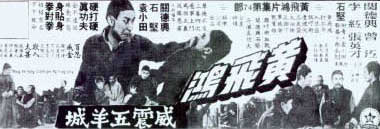
(Wong Fei Hung - the Incredible Success
in Canton - 1968)
Thus, through the years W-F-H faced such martial-arts as the "Mantis Fist", the "Crane Claw" and the "Genital Crushing Fist", or such weapons as the "Zu Mu" sword, the “Hexagram Rod” and the "Soul-Severing-Spear”. Well known martial artists of the period were also invited on a regular basis as guest performers, including on many occasions Mo Kwei-lan, the widow of the real life Wong Fei-hung, herself a martial artist/dragon dance performer of note. Because of it's emphasis on martial display, the serial firmly established the prominence of the fight choreographer in a way that did not exist before, and served as a training ground for an entire generation who came into their own in the Sixties and Seventies, such as Han Ying Chieh, Tang Chia, Lau Kar Leung and Yuen Woo Ping.
As nothing lasts forever, the W-F-H serial came to an end in the spring of 1970. Ever since the mid-sixties, a new breed of wuxia, dubbed "New Style", had ruled the big screen. Classy, stylish, and cinematically vigorous on one hand, "New style " films were also gloomy in mood, showcased gritty blood-spurting action, and starred angst-filled punk heroes who perfectly mirrored the brash, restless and highly individualistic spirit of a new post-WW II born and bred youth audience. In comparison, the old fashioned serial was hopelessly outclassed, outdated, and out of touch. The last of the serial, WONG FEI HUNG: BRAVELING CRUSHING THE FIRE FORMATION was released in May 1970, and with it went the last remnants of H-K's first great k-f age. What followed was the kung-fu cinema of Wang Yu, Bruce Lee and Chang Cheh, which showcased the most intense, spectacular, and crisp-looking martial-arts displays yet put on screen. These new heroes however used their fighting skills as tools of death and destruction to enact bloody revenge, in complete contradiction to the life-affirming, ethically-centred view of martial-arts once promoted by Master Wong.

(Wong Fei Hung - the Invincible Lion
Dance - 1968)
The old W-F-H movies weren't completely forgotten however. For one thing, many of them were regularly broadcast on TV, and still are to this day. During the second half of the seventies Master Kwan even reprised his famous role for a 13-part TV series. More importantly though, the generation who had been raised either working on or watching the serial, eventually came of age, and drew a great deal of their inspiration directly from the serial when the time came to make their own movies.
The pure classic k-f cinema of Lau Kar Leung, the vivid k-f comedy of Yuen Woo Ping, and the lavish reinterpretation of the Wong Fei Hung universe by Tsui Hark in ONCE UPON A TIME IN CHINA all resulted from a rekindling of the original serial and it’s lore. That martial art cinema came back time and time again to the W-F-H serial to renew itself, is testimony to both its central role within the genre, and of its great richness. And yet to present the serial as where the k-f film genre found its roots would still be like somewhat selling it short. Truly, Master Kwan's total dedication to his role gave a heart and soul for the whole genre to come.
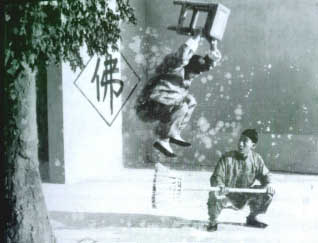
(Wong Fei Hung and the Courtesan's
Boat Argument - 1956)
To this day The W-F-H serial remains one of the
most respected brands of wuxia movie ever done by both the Cantonese-speaking
viewers who grew up on them as well as scholars and historians who value highly
the serial as a invaluable cultural storehouse of folk customs (many of which
have disappeared since the time of their recording) and single it out for
it’s ethical, altruistic and pedagogical aspect which was brought to it.
To them the series for all it’s antiquity and cinematic limitations came
to truly represent what is the best and most dignified in H-K wuxia/martial
art cinema.
THE CINEMA OF WONG FEI HUNG, Hong Kong Urban Council, 1996.
Yu Mo-wan, "Prodigious cinema of Wong Fei Hung", A STUDY OF HONG KONG MARTIAL ART FILM, Hong Kong Urban Council 1980.
Hector Rodriguez "Hong Kong popular culture as an interpretive arena: the Huang Feihong film series", Screen 38:1 Spring 97.
Bey Logan, HONG KONG ACTION CINEMA, 1996
Stephan Teo, HONG-KONG THE EXTRA DIMENSION, BFI publishing 97.
Acknowledgments.
Special thanks to Art Black (where ever you are now) for providing me with both a tape of the film and written pieces on the subject.
Thanks for Zac Campbell, Linn Hayes and Brian Nass for their support, suggestion and help during the course of making this piece.
Dedicated to the Great Master Kwan Tak Inn and
producer/director Wu Ping with out whom the Wong-Fei Hung series and everything
that follow would not have been possible.